There were five campaign medals available for individuals who saw service in the First World War. An individual, male or female, could be issued with a maximum of three of these medals, although there are a small number of exceptions to the rule.
Service medals were issued automatically to other ranks, but officers or their next of kin had to apply for them. Medals were engraved with the name of the recipient and usually included some or all of the following information: service number, rank, first name or initial, surname and military unit (Regiment or Corps). This was either on the rim of the medal or in the case of a star, on the reverse. In addition to the five campaign medals a badge was available to officers and men who had been honourably discharged or had retired as a result of sickness or wounds from war service.
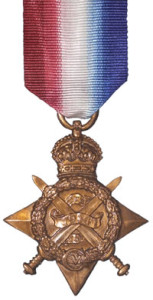 The 1914 Star (Established in April 1917)
The 1914 Star (Established in April 1917)
This bronze medal was awarded to those who had served in France or Belgium between 5th August 1914 and midnight on 22nd November 1914. The award was open to officers and men of the British and Indian Expeditionary Forces, doctors, and nurses, as well as Royal Navy, Royal Marines, Royal Navy Reserve, and Royal Naval Volunteer Reserve who served ashore with the Royal Naval Division in France or Belgium.
The reverse of the medal is plain but has the recipient’s service number, rank, name, and unit engraved on it.
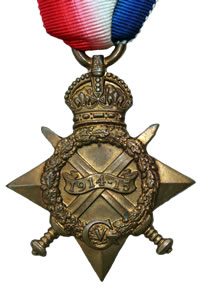 The 1914-15 Star (Established in December 1918)
The 1914-15 Star (Established in December 1918)
This is another bronze medal very similar to the 1914 Star but it was issued to a much wider range of recipients. It was awarded to all who served in any theatre of war against Germany between 5th August 1914 and 31st December 1915, except those eligible for the 1914 Star. Similarly, those who received the Africa General Service Medal or the Sudan 1910 Medal were not eligible for the award.
As in the case of the previous medal, the reverse is plain except for the recipient’s service number, rank, name, and unit engraved on it.
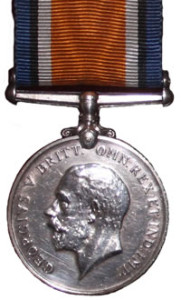 The British War Medal, 1914-18 (Established on 26th July 1919)
The British War Medal, 1914-18 (Established on 26th July 1919)
This was a silver or bronze medal awarded to officers and men of the British and Imperial Forces who either entered a theatre of war or entered service overseas between 5th August 1914 and 11th November 1918. This was later extended to services in Russia, Siberia and some other areas in 1919 and 1920.
The recipient’s service number, rank, name and unit was engraved on the rim.
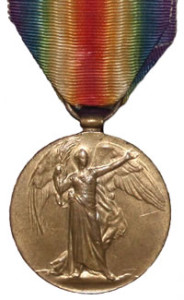 The Allied Victory Medal
The Allied Victory Medal
This medal was issued after the war, to celebrate the Allies’ victory. It was decided that each of the allies should issue their own bronze victory medal with a similar design, similar equivalent wording, and identical ribbon.
The recipient’s service number, rank, name and unit was engraved on the rim.
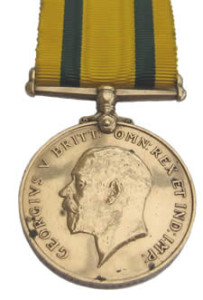 Territorial Force War Medal, 1914-1919 (Instituted on 26th April 1920)
Territorial Force War Medal, 1914-1919 (Instituted on 26th April 1920)
Only members of the Territorial Force or the Territorial Force Nursing Service were eligible for this medal. They had to have been a member of the Territorial Force on or before 30th September 1914 and to have served in an operational theatre of war, outside the United Kingdom, between 5th August 1914 and 11th November 1918. An individual who was eligible to receive the 1914 Star or 1914/15 Star could not receive the Territorial War Medal.
The front of the medal shows an effigy of King George V with the words GEORGIVS BRITT OMN:REX ET IND: IMP: The reverse of the medal has the words TERRITORIAL WAR MEDAL around the rim, with a laurel wreath and the words inside the wreath FOR VOLUNTARY SERVICE OVERSEAS 1914-1919.
 The Silver War Badge
The Silver War Badge
The Silver War Badge was issued on 12th September 1916 and was originally awarded to officers and men who were discharged or retired from the military forces as a result of sickness, or injury caused by their war service. After April 1918 the eligibility was amended to include civilians serving with the Royal Army Medical Corps, female nurses, staff, and aid workers.
Around the rim of the badge was inscribed “For King and Empire; Services Rendered”. For this reason it also became known as the “Services Rendered Badge”. Each badge was engraved with a unique number on the reverse, although this number is not related to the recipient’s Service Number. The recipient would also receive a certificate with the badge. The badge was made of Sterling silver and was intended to be worn on the right breast of a recipient’s civilian clothing. It could not be worn on a military uniform.
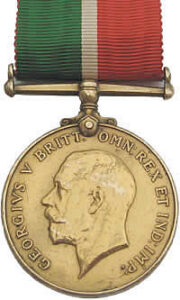 Mercantile Marine War Medal (Established in 1919)
Mercantile Marine War Medal (Established in 1919)
The Board of Trade awarded this campaign medal, the Mercantile Marine War Medal, to people who had served in the Merchant Navy and who had made a voyage through a war zone or danger zone during the 1914-1918 war.
It is a circular bronze medal, about 33cms in diameter. On the front there is an effigy of King George V facing to the left with the words GEORGIVS V BRITT: OMN: REX ET IND: IMP: The reverse of the medal has a laurel wreath around the rim with an image of a merchant ship on a stormy sea with an enemy submarine and an old sailing ship to the right of the merchant ship. The inscription on this side of the medal is FOR WAR SERVICE/MERCANTILE MARINE 1914-1918.
The ribbon (3.1cms wide) is green on the left and red on the right with a thin white line in the centre between the two. The green and red colours on the ribbon represent the starboard and port running lights of a ship, with the centre white colour being representative of the masthead steaming light.
British Campaign Medal Sets
Campaign medals were often presented in sets, and these sets were given nicknames, such as:
‘Pip’, ‘Squeak’, and ‘Wilfred’
‘Pip’, ‘Squeak’, and ‘Wilfred’ are the affectionate names given to the three First World War campaign medals — The 1914 Star or 1914-15 Star, British War Medal and Victory Medal. These medals were primarily awarded to the Old Contemptibles (B.E.F. – British Expeditionary Force) and by convention all three medals are worn together and in the same order from left to right when viewed from the front. The set of three medals or at least the British War Medal and the Victory Medal are the most likely medals to be found among family heirlooms.
About the same time that these First World War medals were issued in the 1920’s, there was a popular comic strip published by the Daily Mirror newspaper. The characters were a dog named ‘Pip’, a penguin named ‘Squeak’, and a young rabbit named ‘Wilfred’. For some reason, perhaps because of their popularity, the three names of the characters became associated with the three campaign medals being issued at that time to many thousands of returning servicemen, and they stuck.
“Mutt and Jeff”
Curiously the British Medal and Victory Medal were also known as Mutt and Jeff. Mutt and Jeff was a popular long running American newspaper comic strip. Mr. Mutt was a tall lanky man who loved horse-racing and Mr Jeff who was added later was a shabbily dressed man in a top hat and suit who started off as an inmate at an asylum who shared Mutt’s love of gambling. There is no clear evidence as to why two British war medals were nicknamed after two American comic-strip characters.
Images courtesy of www.greatwar.co.uk

